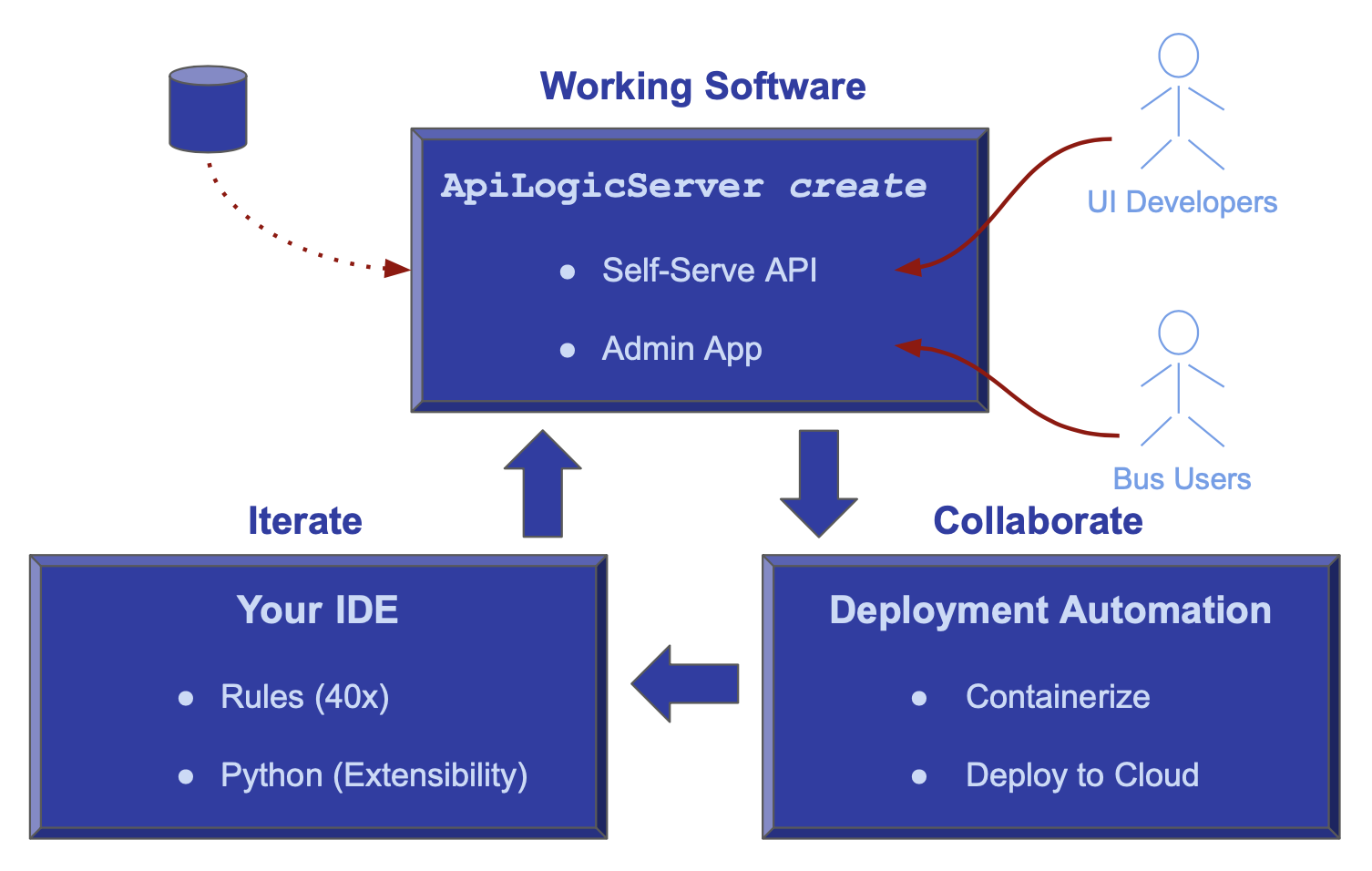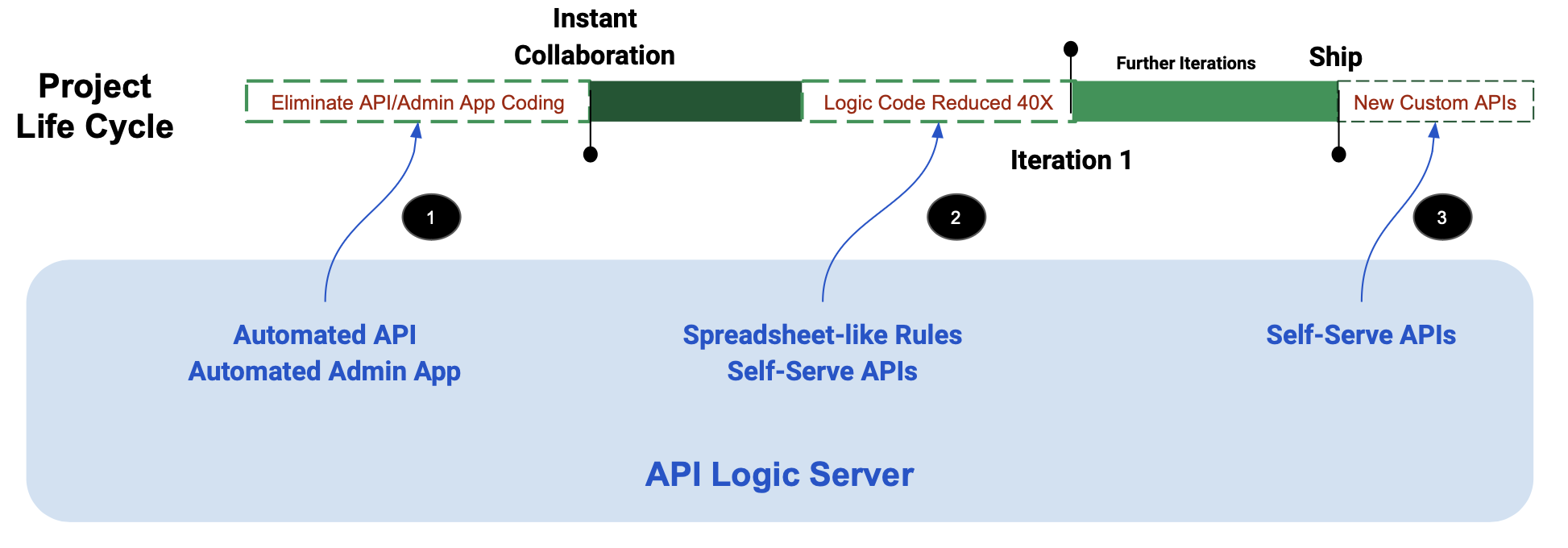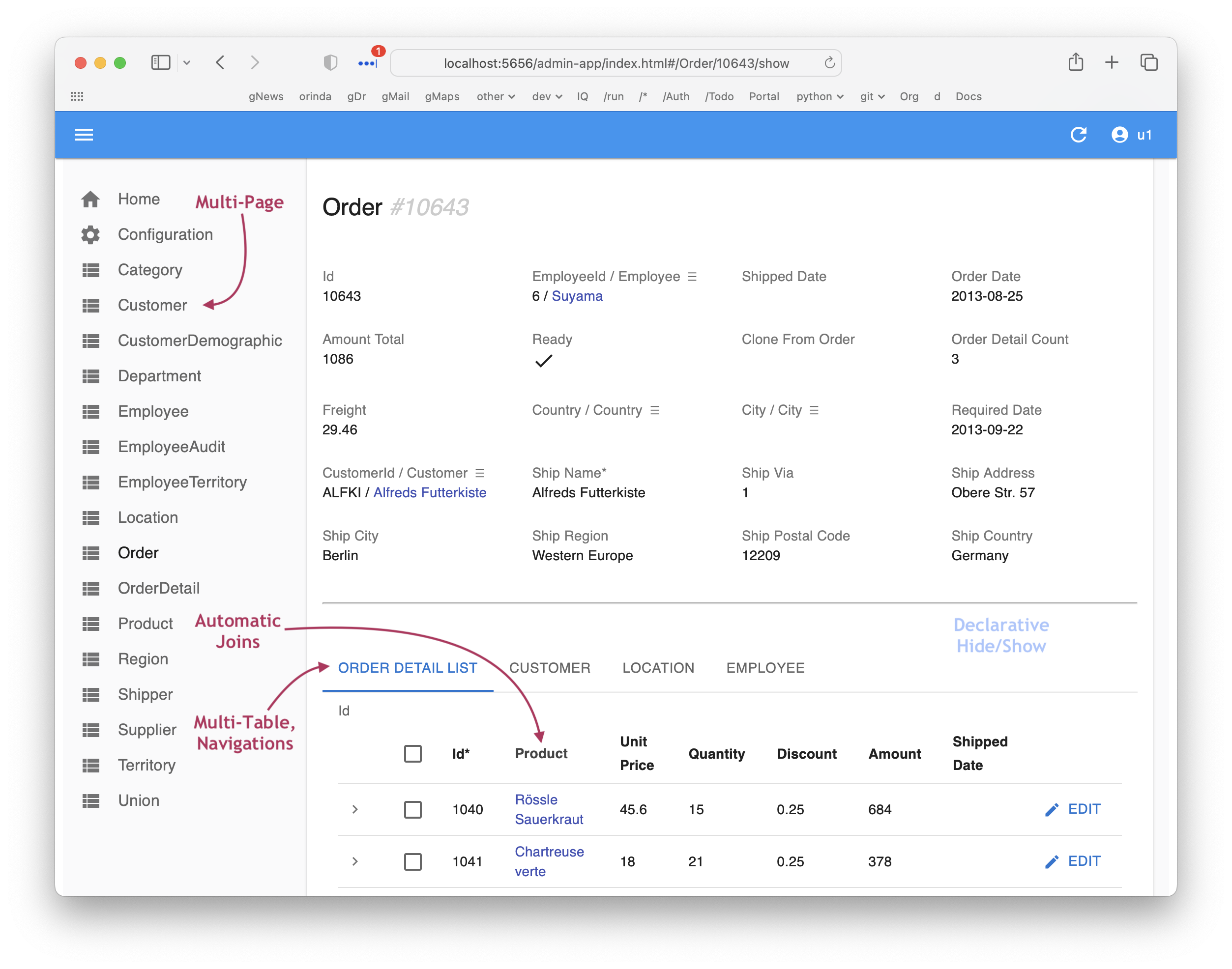Tech Agile

The Problem: Late, and Wrong
So, why does this keep happening?
Why: Delayed Collaboration
It’s because Business Users need working software - running screens - but there’s a long dev cycle before that happens..


Need: Instant Working Software.. Now
The Agile vision is shown on the right: getting Working Software as fast as possible, to facilitate Business User Collaboration and Iteration.
And that's exactly why we built API Logic Server: it creates working software instantly, instead of weeks/months, as shown below:

- Use your existing database, or create a new one with ChatGPT or your database tools
- Create Working Software Now: API Logic Server creates an ApiLogicProject, providing:
- A Self-Serve API that UI developers can use, Day 1 - no waiting for server dev
- An Admin App for Business Users to begin collaboration, Day 1
- Deploy for Collaboration: e.g. to the Azure Cloud
- Iterate: declare logic and security, with Python as required
This process leverages your existing IT infrastructure: your IDE, GitHub, the cloud, your database… open source
Let's see how.
1. Acquire Database
You can use an existing database, or create a new one with ChapGPT or your database tools.
For this Tutorial, to get a simple customers/orders database, click the download link here.
2. Create Working Software
Given a database, API Logic Server creates an executable, customizable project:
$ ApiLogicServer create \
--project_name=ai_customer_orders \
--db_url=sqlite:///ai_customer_orders_begin.sqlite
This creates a project you can open with VSCode. Establish your venv, and run it via the first pre-built Run Configuration. To establish your venv:
python -m venv venv; venv\Scripts\activate # win
python3 -m venv venv; . venv/bin/activate # mac/linux
pip install -r requirements.txt

The project is now ready to run. It includes a self-serve API ready for UI developers, and an Admin app ready for Business User Collaboration. We have eliminated the first project segment from our traditional project timeline, and can start collaboration on Day 1.
Our timelines looks more like this:

Let's have a look.
a. Admin App
This React-Admin web app is created automatically - no JavaScript, no HTML.
It's the Working Software Business Users need to collaborate on Day 1: confirm the data model, and uncover logic requirements.

b. Self-serve APIs
The system automatically creates JSON:APIs, supporting related data access, pagination, optimistic locking, filtering, and sorting.
UI Developers can use swagger to design their API call, and copy the URI into their JavaScript code. APIs are thus self-serve no server coding is required. UI development is unblocked, Day 1.

3. Deploy for Collaboration
OK, running on our desktop. We need to deploy it for collaboration.
API Logic Server also creates scripts for deployment.
a. Containerize
We'll create a container and deploy to Azure. In a terminal window for your project:
b. Test your Image
You can test the image in single container mode:
c. Upload Image (optional)
You would next upload the image to docker hub.
If you use the same names as here, skip that, and use our image:
apilogicserver/aicustomerorders.
d. Push the project
It's also a good time to push your project to git. Again, if you've used the same names as here, you can use our project.
e. Deploy to Azure Cloud
Login to the azure portal, and:
git clone https://github.com/ApiLogicServer/ai_customer_orders.git
cd ai_customer_orders
sh devops/docker-compose-dev-azure/azure-deploy.sh
4. Iterate: Declare Rules
Collaboration might uncover a requirement for Check Credit. Let’s implement it…
a. Declare Logic
Rules are an executable design. Use your IDE (code completion, etc), to replace 280 lines of code with the 5 spreadsheet-like rules below. Note they map exactly to our natural language design:
''' Declarative multi-table derivations and constraints, extensible with Python.
Brief background: see readme_declare_logic.md
Use code completion (Rule.) to declare rules here:
1. Customer.Balance <= CreditLimit
2. Customer.Balance = Sum(Order.AmountTotal where unshipped)
3. Order.AmountTotal = Sum(Items.Amount)
4. Items.Amount = Quantity * UnitPrice
5. Items.UnitPrice = copy from Product
'''
Rule.constraint(validate=models.Customer, # logic design translates directly into rules
as_condition=lambda row: row.Balance <= row.CreditLimit,
error_msg="balance ({round(row.Balance, 2)}) exceeds credit ({round(row.CreditLimit, 2)})")
Rule.sum(derive=models.Customer.Balance, # adjust iff AmountTotal or ShippedDate or CustomerID changes
as_sum_of=models.Order.AmountTotal,
where=lambda row: row.ShipDate is None) # adjusts - *not* a sql select sum...
Rule.sum(derive=models.Order.AmountTotal, # adjust iff Amount or OrderID changes
as_sum_of=models.Item.Amount)
Rule.formula(derive=models.Item.Amount, # compute price * qty
as_expression=lambda row: row.UnitPrice * row.Quantity)
Rule.copy(derive=models.Item.UnitPrice, # get Product Price (e,g., on insert, or ProductId change)
from_parent=models.Product.UnitPrice)
Observe rules are declared in Python. Given IDE services for code completion, this is using Python as a DSL (Domain Specific Language).
-> Re-use and Optimization
We can contrast this to the (not shown) ChatGPT attempt at logic. With declarative logic, you get:
-
Automatic Reuse: the logic above, perhaps conceived for Place order, applies automatically to all transactions: deleting an order, changing items, moving an order to a new customer, etc.
-
Automatic Optimizations: sql overhead is minimized by pruning, and by elimination of expensive aggregate queries. These can result in orders of magnitude impact.
ChatGPT created triggers that missed many Use Cases, and were inefficient. They were also not transparent; Business Users can read the rules and spot issues ("hey, where's the tax?"), certainly not triggers.
b. Add Security
In a terminal window for your project:
Users will now need to sign in to use the Admin App.
5. Next Iteration: Rules + Python
Not only are spreadsheet-like rules 40X more concise, they meaningfully simplify maintenance. Let’s take an example.
Green Discounts
Give a 10% discount for carbon-neutral products for 10 items or more.
Automation still applies; we execute the steps below.
a. Add a Database Column
b. Rebuild the project, preserving customizations
cd .. project parent directory
ApiLogicServer rebuild-from-database --project_name=ai_customer_orders --db_url=sqlite:///ai_customer_orders/database/db.sqlite
c. Update your admin app
Use your IDE to merge /ui/admin/admin-merge.yml -> /ui/admin/admin.yml.`
d. Declare logic
def derive_amount(row: models.Item, old_row: models.Item, logic_row: LogicRow):
amount = row.Quantity * row.UnitPrice
if row.Product.CarbonNeutral and row.Quantity >= 10:
amount = amount * Decimal(0.9)
return amount
Rule.formula(derive=models.Item.Amount, calling=derive_amount)
This simple example illustrates some significant aspects of iteration.
a. Maintenance: Logic Ordering
Along with perhaps documentation, one of the tasks programmers most loathe is maintenance. That’s because it’s not about writing code, but it’s mainly archaeology - deciphering code someone else wrote, just so you can add 4 or 5 lines they’ll hopefully be called and function correctly.
Rules change that, since they self-order their execution (and pruning) based on system-discovered dependencies. So, to alter logic, you just “drop a new rule in the bucket”, and the system will ensure it’s called in the proper order, and re-used over all the Use Cases to which it applies.
b. Extensibility: Rules + Python
In this case, we needed to do some if/else testing, and it was more convenient to add a dash of Python. While you have the full object-oriented power of Python, this is simpler, more like Python as a 4GL.
What’s important is that once you are in such functions, you can utilize Python libraries, invoke shared code, make web service calls, send email or messages, etc. You have all the power of rules, plus the unrestricted flexibility of Python.
c. Debugging: IDE, Logging
The screen shot above illustrates that debugging logic is what you’d expect: use your IDE's debugger.
In addition, the Logic Log lists every rule that fires, with indents for multi-table chaining (not visible in this screenshot). Each line shows the old/new values of every attribute, so the transaction state is transparent.
d. Rebuild: Logic Preserved
Note we rebuilt the project from our altered database, without losing customizations.
Summary

In 6 minutes, you've used ChatGPT and API Logic Server to convert an idea into working software -- 5 rules, 4 lines of Python. The process was simple:
-
Used the
ApiLogicServer createcommand to create an executable project- A Self-Serve API to unblock UI Developers -- Day 1
- An Admin App for Business User Collaboration -- Day 1
-
Enabled Collaboration with automated deployment services
-
Iterated the project in your IDE to implement new requirements
- With Rules -- 40X more concise than code
- And Python -- for complete flexibility
It all works with standard tooling: Python, your IDE, and container-based deployment.